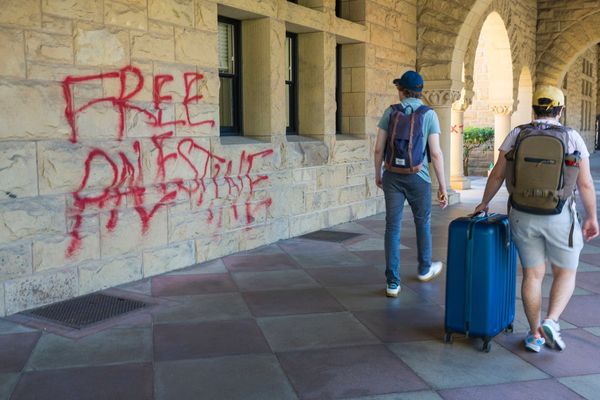
The Egyptian Ministry of Tourism and Antiquities has announced the discovery of five historic cemeteries in the Saqqara region, Giza, (western Cairo) that belong to major statesmen from the Old Kingdom (2686-2181 BC), and the First Intermediate Period (2181-2055 BC), dating to over 4,600 years ago. The ministry organizes a media tour in the site on Saturday to explore the cemeteries.
Minister of Tourism and Antiquities Khaled El Anani visited the discovery site to examine the excavation works led by the Egyptian mission near the King Merenre pyramid in Saqqara. “Five engraved cemeteries containing burials and antiquities from the Old Kingdom and the First Intermediate Period have been discovered in the Saqqara region, which saw many archeological discoveries in the past years,” the minister noted in an official statement.
“This discovery will help rewrite the First Intermediate Period in the Egyptian history because it could provide more information about those who lived and ruled during that period. It was a critical phase in the Egyptian history, it saw the political and economic collapse of the state, the independence of rulers each in his region, and an economic deterioration caused by wasting the state’s resources on building the pyramids in the Old Kingdom, in addition to the scarcity of Nile water and its impact on agriculture,” Dr. Hussein Abdul Bassir, director of the Bibliotheca Alexandrina (BA), told Asharq Al-Awsat.
Saqqara is a part of the Memphis cemetery, located 40 km west of Cairo, and was named after God Seker from the Old Kingdom. The region is an open museum featuring antiquities from different eras of the Egyptian history.
“The first cemetery, burying a senior statesman named Eri, includes a well leading to a burial chamber with engraved walls featuring funerary drawings including sacrifices tables, the palace’s façade, containers of the seven oils, a huge tomb built of limestone, and a collection of engraved pieces that belonged to the cemetery’s owner,” said Mostafa Waziri, secretary-general of the Supreme Council of Antiquities of Egypt and head of the Saqqara mission, in a press statement.
“The archeological mission currently works on cleaning and documenting the discovered cemeteries,” he added.
The second cemetery, a rectangle-shaped well belongs to the wife of a man named ‘Yart’. The third belongs to a man who had many titles including the supervisor of the grand house. The fourth cemetery belongs to a lady, ‘Betty’ who held many titles; it’s a rectangular well located at six meters underground. Built for a man called ‘Heno’, the fifth cemetery is a rectangular well built at seven meters underground. Its owner had many titles including the supervisor of the royal palace and the mayor.
The Pyramid of Djoser, the oldest stone construction in history, is Saqqara’s most known landmark. The Saqqara archeological site includes the cemeteries of kings and senior statesmen from the 1st and 2nd Dynasties, in addition to king pyramids from the 5th and 6th Dynasties including the King Wenis Pyramid, who was the first to engrave his burial chamber with texts to protect himself during his journey in the other world.
The region also features cemeteries of statesmen from the Old Kingdom, the First Intermediate Period, the Middle Kingdom of Egypt (2055-1650 BC), and the New Kingdom (1550-1069 BC) known for its unique architecture and constructions such as the cemetery of King Horemheb (1323-1295 BC).
The region also houses the cemetery of sacred calf Apis, known as Serapeum of Saqqara, which was used from the 18th Dynasty until the Ptolemaic Kingdom. But Saqqara is not only Pharaonic; it includes Coptic landmarks such as the Monastery of Anba Ermia, located to the southeast of King Djoser’s pyramid collection. The Monastery was used until the 10th century AD.
Over the past year, Saqqara witnessed many archeological discoveries including hundreds of colored tombs containing well-preserved mummies of senior statesmen and priests from the 26th Dynasty, selected among the world’s top 10 archeological discoveries in 2020. Two cemeteries of priest Wa Ti, and the supervisor of the royal palace ‘Khoy’, in addition to several cat cemeteries were unearthed last year as well.







